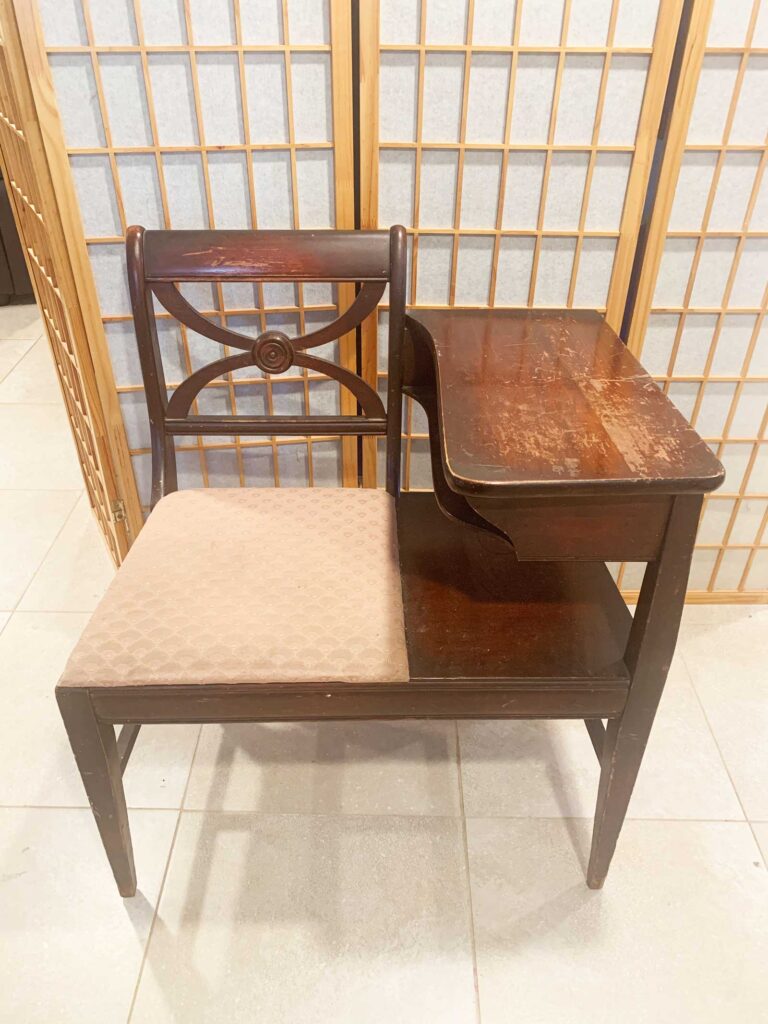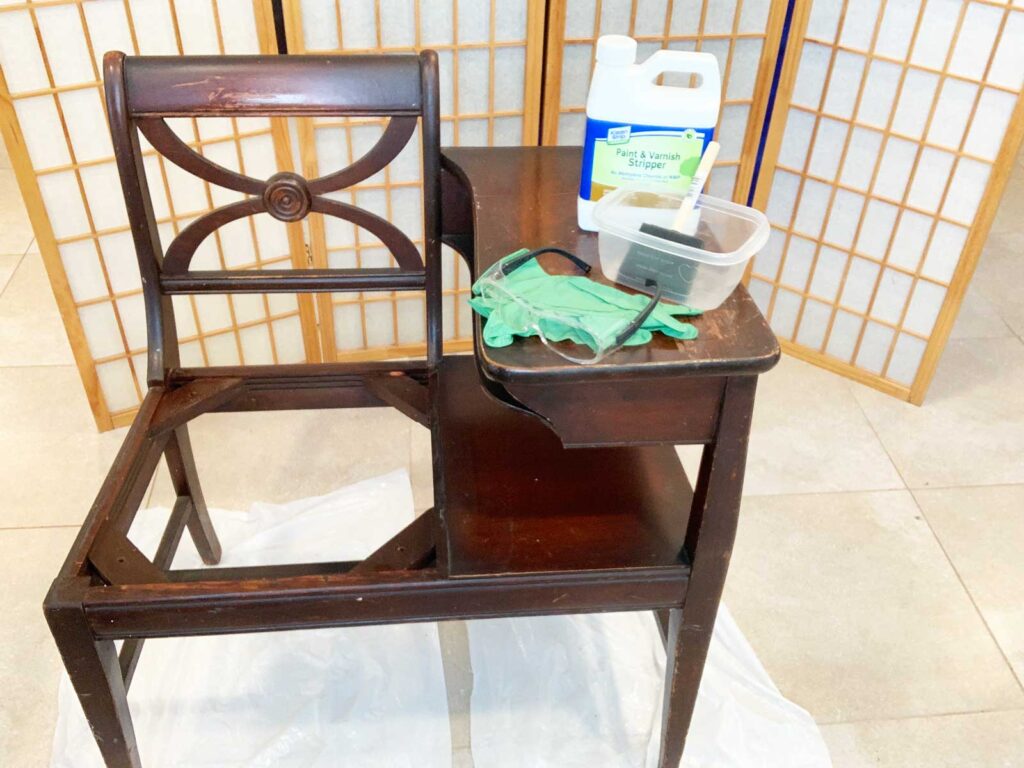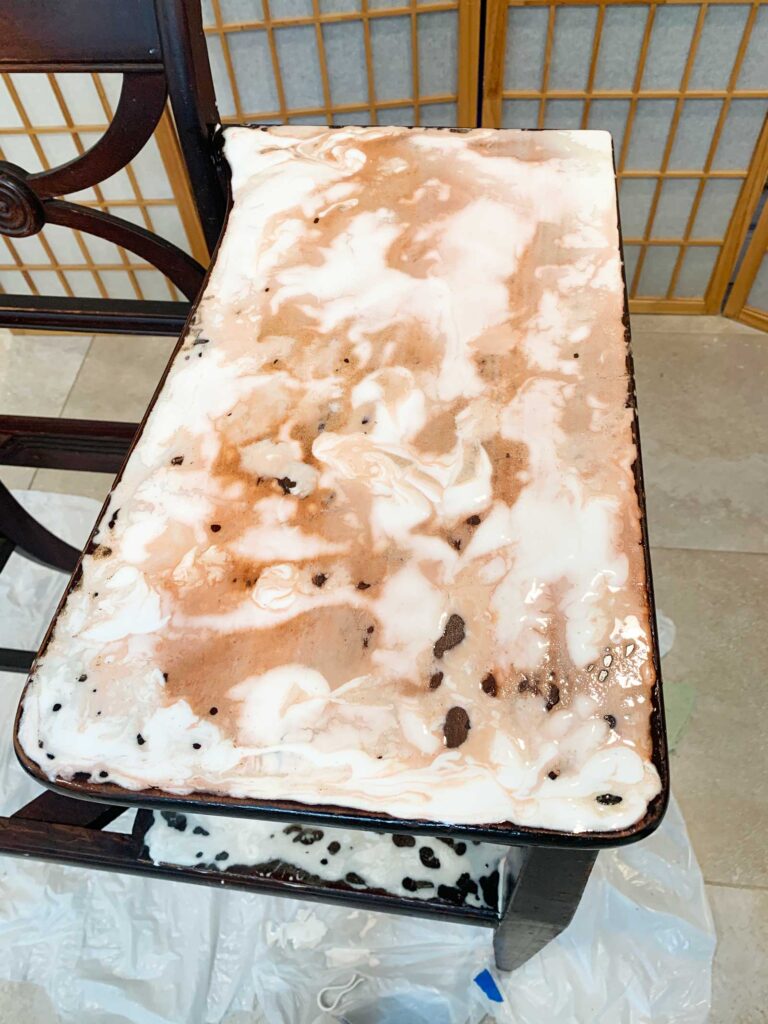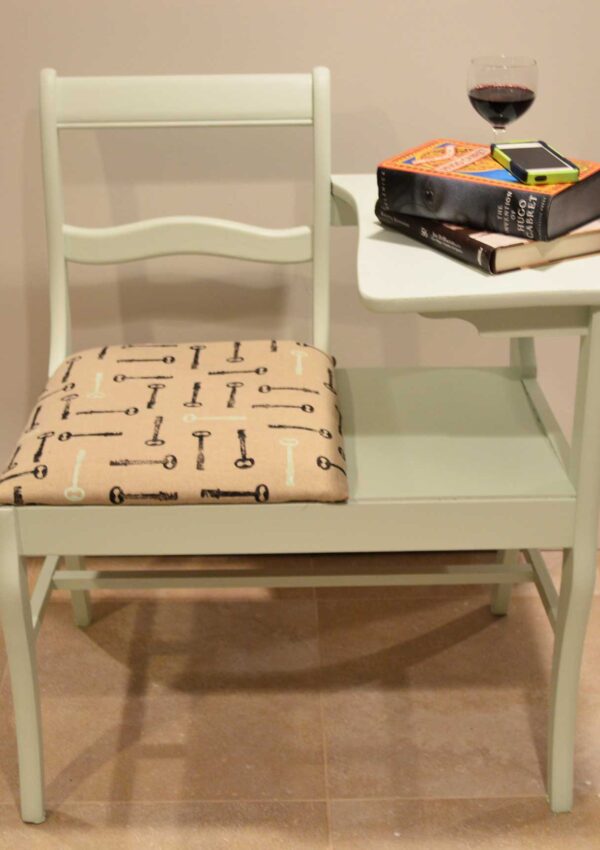
My blog periodically contains affiliate links meaning that if you make a purchase, I might make a small commission at no extra charge to you. Purchases made through them are greatly appreciated.
This telephone chair DIY that looks amazing, didn’t start out like this. These telephone chairs were popular at a time when a phone needed a table to sit on, and a chair for a person to sit on. What I love about these old telephone chairs is the idea of taking an old nonfunctional piece of furniture and upcycling it to a useful piece with new function.
Table of Contents
Other names this telephone chair goes by

When I started Double Arrow Designs with my sister Nicole years ago. We upcycled our first telephone chair makeover that was so amazing to do! When looking for these chairs they are listed under a few different names. First being a telephone chair or bench and another name that this goes by is gossip chair or gossip bench. All of these names depict the use of this piece of furniture. The gossip chair was coined by the hours a person would sit at these telephone chairs and gossip on the phone.
Check out My YouTube video on the telephone chair process!
Original Telephone chair
This original telephone chair was bought in this condition. Right away I knew I would need to strip and reupholster the seat. Also the dark wood finish needed to be changed. In this past post How to Refinish A Secretary desk I bleached part of the wood, I loved how this came out so much that I decided that I would use this same bleach method on the tabletop of this telephone chair. Then paint the rest a neutral color. My friend Nicole Delacruz creator of Inspired Design Talk gave me all these fabulous home furnishing textile swatches and I am going to lay out the ones that work to create my new upholstered seat.
Prepping your furniture piece
Before I start any furniture project I clean my piece well. I get a bucket of warm sudsy water and a sponge or a rag and wash down my piece from top to bottom. A lot of these older pieces have collected dust, grime and dirt. This is so important to remove any of this before you start.
How to remove old varnish from wood
Since this is a dark stained piece, I need to remove the stain from the table top of my telephone chair in order to prepare for bleaching. I am using Klean Strip Paint and varnish remover. I apply as directed, let it sit, then with a putty knife, I take up the loosened varnish finish. It’s important to go in one direction and try and follow the grain of the wood to keep a consistent finish. once this is removed I will prepare to bleach the top.
The directions said leave on for an hour, I left on for a few hours and reapplied during this time more gel to continue to cover the surface. Once I had removed the old varnish and some of the stain, I still needed to sand the surface to remove the remaining stain that was sitting on the surface of the wood. I used a hand held hand sander for this. Since it’s battery operated I had an additional battery charging to switch out when the battery I was using died, in order to continue to sand without stopping.
Steps to bleaching wood
Once I have stripped the old varnish off the wood,and hand sanded the remaining stain off I was ready to bleach! I break down the process below in super easy steps and the supplies you will need.
Supplies
- Household bleach
- gloves
- distilled white vinegar
- water
- sponge brushes
- protective eyeglasses
- sanding block fine grit– I used 220 (The higher the number the finer the git- the lower the number the coarser the grit is)
Process for bleaching wood
- You must remove any varnish or stain from your wood. I sanded down my secretary desks wood, but in this project I am going to use a varnish stripper, then sand the rest of the stain with my hand sander.
- Once all finishes have been removed you are ready to go!
- Wood must be dry, with either a sponge brush, regular brush or paper towel, paint household bleach onto surface in direction of the wood grain.
- Let sit for 4 hours- You will see the wood lighten before your eyes as the bleach dries on the wood.
- After the four hours take equal parts white vinegar and water. Wipe wood down with this. This will neutralize the bleaching process.
- Let wood completely dry. The surface will feel slightly rough from the bleach. Use a sand block (fine grit) and lightly sand any roughness the bleach has left behind. You will be left with a smooth bleached wood surface.
- You now can seal this wood with a wax or a poly acrylic. on this specific project I will use a clear matte poly acrylic top coat. I am doing this because the table top will be a high traffic area for objects and touching.
- Once my first poly acrylic coat has dried, I will lightly sand and apply a second coat to ensure that it is fully sealed. You can repeat this process depending on how many coats you would like to have on your piece.
Priming my telephone chair
Now that I have bleached the table of my telephone chair, I will cover this with paper and painters tape to protect it from my next step. PRIMING
I am a huge fan of Zinsser BIN primer. You can use any primer you have, however on dark wood pieces like this you need to use a primer that will block any tannins of the wood seeping through. Zinsser BIN primer is a shellac based primer that will do the trick. A few important things to know when working with this primer.
- Pour what you need into a small container. I do this so I do not contaminate the whole can of primer by redipping my brush into the can.
- Cover the can of primer once you take what you need. This primer dries FAST. To keep the balance of your primer in good condition , keep it covered.
- Use a brush, and in one fluid motion, apply the primer. THEN LEAVE IT ALONE. As I have said above, this primer dries fast and if you try and go over it, it will be tacky and you will have a rough surface. Set it and forget it!
- One coat of primer makes your project look like a disaster! Keep in mind that a second coat will fill in more of the brush strokes and areas that are peeking through.
- Once your two coats are complete let your piece thoroughly dry. Then will a fine grit sanding block smooth out any roughness or paint drips.
- Cleaning your brushes. Because Zinsser BIN is a shellac based primer, regular soap and water will not clean your brushes. I use equal parts ammonia and water and let my brushes sit in this for a few hours. Then I wash off with soap and water and your brushes are as good as new!
- I only use purdy brushes. They are more expensive, however if you take good care of them they will last you a long time.
- Once both coats of primer are dry, You are ready to paint!
Painting your telephone chair
Wow lots of steps before you get to the fun part! I will always tell anyone who is painting a piece of furniture. That if you prep well, the painting will look amazing! I have done a Telephone Chair Makeover in the past and used Benjamin Moore paint on this. On this project I have decided to use chalk paint. I usually use regular Benjamin Moore, however I had bought this Annie Sloan chalk paint a while ago in Louis blue and thought it was a perfect match to pick up some of the blue in the textile I had used.
I used a contrasting color and different brand paint for the chairs “bullseye” and stenciled birds. This was Fusion Paint in their champlain color. I used both these colors and brands because I had them in my closet and they worked well together and complemented the upholstered fabric I ended up using.
Reupholstering your telephone chair

When you find these telephone chairs, they are usually in worn condition. This includes the upholstered seat. By replacing this textile on your chair you will transform your piece immediately! See below for all the steps to ensure a perfect upholstering job.
- SUPPLIES NEEDED:
- Flathead screwdriver
- Staple gun
- Staples for your staple gun– I used 3/8″ on my project
- Foam
- Fabric (homegoods Textile, see below)
- Sharpie marker
- scissors
- Pick out your textile! This is very important that you pick a homegoods textile and not an apparel textile. You are like, what Susan? what’s the difference? I’ll tell you! Homegoods textiles are more durable and will stand up to use. A lighter weight apparel fabric will become worn and break down over time. When purchasing your textile (fabric) note the description, this will help you make the right decision.
- Remove all the old batting, foam and fabric. You will be left with a wood board. This is the bones of your seat.
- Lay your bare seat onto a piece of foam, this will be your stencil. Then using a sharpie marker, trace the outline of your board, then cut foam to size and shape.
- Place your fabric over the board and cut to size foam. Position how you would like it to look. Then flip it over onto a table top.
- Cut your fabric down, but leave enough to be able to wrap the back of your board by few once. Keep in mind that the foam will take up a few inches so do not do this until you have the board and foam in place.
- With your staple gun, hold and staple your sides in place. What I like to do is this: Staple in the middle of one side, and then do this on the balance of your sides, while slightly pulling the fabric in. Then staple on the outer sides, then rotating and so this on the other sides. This will ensure that you have distributed the tension evenly on all sides.
- Corner of your upholstered seat. This is a little more tricky. You will need to trim your fabric. I like to fold my corners in as neatly as possible and staple into place.
- Once all your corners are complete. fill in the open areas with additional staples.
- Screw your seat into place!
Stenciling your furniture
My pieces most of the time will have an added painted stencil. I create all my own stencils and love this added art feature. As an artist this has given me a creative outlet to add an art element, this helps to incorporate a feel or a look that is totally unique to each of my pieces. You can find all my stencils her on my Double Arrow Etsy store. I am always adding new ones once I have created and used them on a piece to ensure they are workable.
Art for my telephone chair

In the case of this piece, I love the trees that are on my upholstered seat. I decided to create a stencil of birds. By adding this extension, of the birds in flight the tree motif and design continues from fabric to wood. I love this transition!
Finishing touches

Once your painting is complete, it’s important to seal your piece. I use Poly acrylic matte finish for the majority of my painted furniture pieces. This goes on clear and dries quickly. I have tried polyurethane in the past but I do not like the yellow look it leaves behind.
Add felt tabs to all the bottoms of your feet! So important so that your furniture can be easily moved without scratching your floor surface, this also helps to level out any wobbly pieces. You may have to add a double layer on one foot to even this out.
Each step during the upcycle of this telephone chair, I documented. I did this in order to show the actual process. As an artist I always love a visual! Hope you enjoy, any feedback is always welcome!
Sign up to be in the know!
I do a new DIY every week, It may be furniture, homegoods, apparel or printables. So many fun, usable ideas! Sign up for my newsletter so you can keep up to date with all my DIY projects and free printables!












Leave a Reply